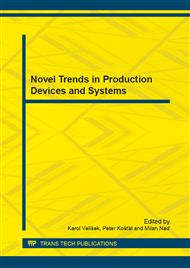p.303
p.309
p.315
p.321
p.327
p.333
p.339
p.345
p.351
Machining Capabilities of Graded Materials by Cutting Processes
Abstract:
Professional paper shows the general characteristics of graded materials, their previous industrial use and potential use of graded materials in the future. In any case, today the use of graded materials is increasing and moving from the laboratory environment into everyday use. However, the subsequent processing of the graded material remains the big unknown, and represents a major challenge for researchers and industry around the world. It could be said that the study of machinability of these materials is in its infancy and in this area are many unanswered questions. Machinability problem of graded materials was undertaken at the Faculty of Mechanical Engineering in Maribor. After a radical study of the literature and potential machining processes of graded materials, we started with the implementation of cutting processes on the workpiece. This professional paper presents the first results of the analysis, which will be used for further research and machinability study of graded materials.
Info:
Periodical:
Pages:
327-332
Citation:
Online since:
January 2014
Authors:
Keywords:
Price:
Сopyright:
© 2014 Trans Tech Publications Ltd. All Rights Reserved
Share:
Citation:


